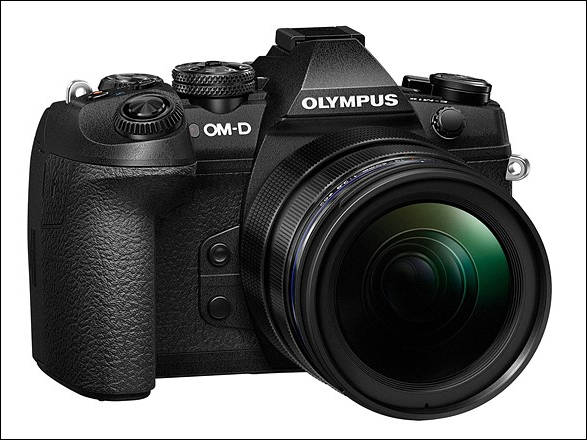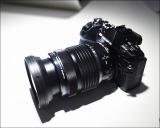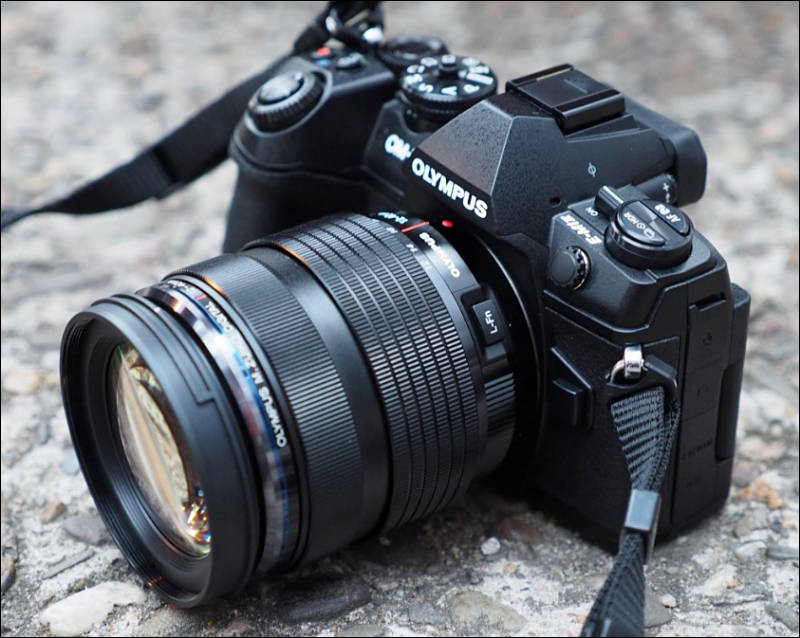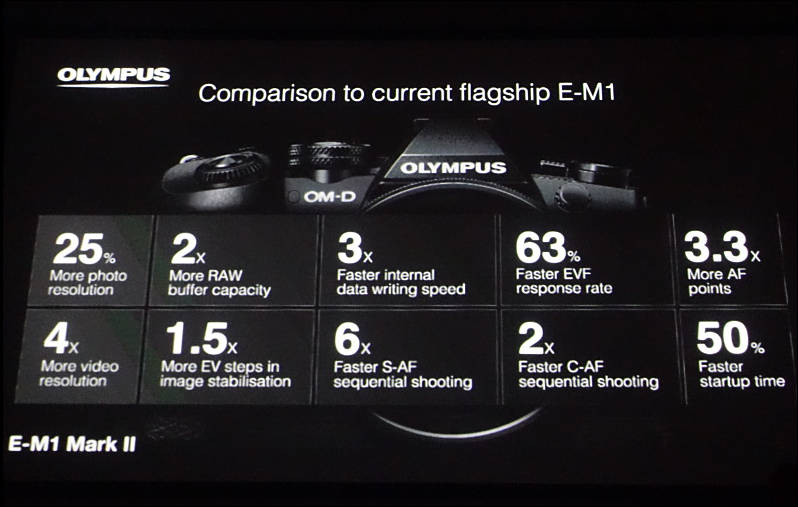
-

Specifications
- 20Mp Sony m43 sensor
- 4K30 and 4K24 Cine video modes, no crop, up to 237Mpix
- Improved 5-axis stabilizer, up to 6.5 stops
- Additional digital stabilization, adds 8% crop
- 121 Phase AF points
- TruePic VIII 4 core LSI
- Articulating touch screen
- 3 or 5 microphones for 3D audio (ala Panasonic or Sony camcorders)
- 18fps burst with AF, 60fps (1 second) with fixed focus, both are with electronic shutter
- 10fps burst with AF, 15fps with fixed focus with mechanical shutter
- Improved EVF with 120fps refresh (before shooting starts, obviously)
- 14 frames preshoot buffer upon half press
- 50Mp sensor shift mode (still not working without tripod!)
- Dual SD cards slot
- HDMI 422 10-bit output
- $1999 body at https://www.amazon.com/Olympus-V207060BU000-Dynamic-Thirds-Digital/dp/B01M4MB3DK/
More info at http://www.getolympus.com/digitalcameras/omd/e-m1-mark-ii.html
-
Forgot to post the link. Here: http://www.43rumors.com/ft4-olympus-e-m1ii-prototype-uses-current-sony-20mp-mft-sensor/
-
Updated expected specs in first topic with all latest rumors.
-
Olympus announces the development of its newest flagship camera and the latest addition to the award-winning OM-D series, the Olympus® OM-D E-M1 Mark II, a compact system camera with performance capabilities that surpass pro-level DSLRs. The Olympus OM-D E-M1 Mark II will be designed to deliver incredible speed, superior image resolution and a host of new shooting features to expand the boundaries of photographic expression.
The OM-D E-M1 Mark II will be equipped with the newly-developed high-speed TruePic VIII Image Processor which is 3.5 times faster than previous TruePic processors and a new 20.4 megapixel Live MOS sensor equipped with 121 points of cross-type on-chip phase detection and contrast detection AF. These technologies will work with the camera’s electronic shutter to provide full resolution images at up to an unprecedented 60 frames per second in AF and AE lock, and up to 18 frames per second with continuous AF and AE tracking.
The advanced Dual FAST AF system will automatically select between contrast and phase detection AF depending on lens type, camera settings and lighting conditions to ensure accurate focus and sharp image quality. In addition, the continuous AF tracking performance will be dramatically improved with a new moving subject tracking algorithm.
The OM-D E-M1 Mark II will boast a wide array of shooting features including a new Pro Capture Mode for lag-free shooting that enables the capture of split-second moments, a 50 Megapixel High Res Shot Mode for images with incredible detail that rivals that of full-frame DSLRs, in-body 5-Axis Image Stabilization with a maximum of 5.5 shutter speed steps of compensation performance1, and 5-Axis Sync IS for a maximum of 6.5 shutter speed steps of compensation2 when combined with the new M.ZUIKO® Digital ED 12-100mm f4.0 IS PRO.
The OM-D E-M1 Mark II will be weathersealed to be dustproof, splashproof, and freezeproof (down to 14°F / -10°C) in a compact lightweight design, ideal for shooting in all types of outdoor conditions. The camera will exceed professional photographers’ performance requirements by employing a high-performance durable shutter designed to clear 200,000 actuations, dual memory card slots, and an improved battery capacity of 37 percent from its predecessor model.
Live MOS sensor and TruePic VIII Image Processor
The newly-developed high-speed TruePic VIII Image Processor and a new 20.4 megapixel live MOS sensor will work in concert with the camera’s electronic shutter to provide full resolution images at a maximum 60 frames per second in AF and AE lock, and up to 18 frames per second with continuous AF and AE tracking.
The TruePic VIII Image Processor will boast a dual quad core system with four CPU cores and four image processing cores that achieve image processing speeds approximately 3.5 times faster than the TruePic VII Processor. Because camera operation and image processing functions will be carried out in parallel, transfer speeds and menu operations will be vastly improved over previous models. A new Pro Capture Mode will provide lag-free shooting so users can capture high-quality full resolution images at precise moments with no compromises.
Advanced Dual FAST AF
The advanced Dual FAST AF will automatically choose between on-chip phase detection AF, contrast detection AF, or will utilize both phase and contrast detection simultaneously. This system will boast 121 cross-type on-chip phase detection focus points in order to dramatically improve accuracy. The simultaneous use of contrast detection and on-chip phase detection AF will enable accurate focus in difficult lighting conditions, while a new moving subject tracking algorithm will rapidly and continuously measure the subject-to-camera distance to precisely maintain focus. Finally, an in-camera AF limiter will be included to achieve faster focusing by limiting the focus range of the lens, thus preventing time-consuming focus hunting.
Autofocus functions such as AF Target Mode, AF target position, and face/eye priority AF will be easily set with a single action. AF operations will be enhanced with a new cluster display, which illuminates active sensors to assure the user of focus subject accuracy. The AF Targeting Pad feature will allow users to select the AF point by sliding their finger on the rear touch LCD while looking through the viewfinder.
High-magnification, high-speed electronic viewfinder
The performance of the 1.48x (35mm equivalent) high-magnification, high-resolution electronic viewfinder will rival those of professional full-frame interchangeable lens cameras. With high-speed operation that includes a maximum frame rate of 120 fps and a minimum six-millisecond display time lag during shooting, users will never lose track of fast-moving subjects.
High-speed response
Superior response will be facilitated by a significant improvement in shutter release lag time; this time will be reduced by approximately 30% from that of the predecessor model so users will never miss a photo opportunity. In addition, frame advance speed during playback will be approximately three times faster for faster scrolling and review of images.
-
A compact, lightweight system with excellent portability
The OM-D E-M1 Mark II will feature weatherproof construction in a compact and lightweight design. Coupled with an Olympus M.ZUIKO lens, the OM-D system remains extremely compact, providing the ultimate in portability for shooting and transportation. Hand-held super-telephoto shooting will be possible with the M.ZUIKO Digital ED 300mm f4.0 IS PRO lens (600mm focal length in 35mm equivalent), and this camera and lens combination will even be compact enough to store in carry-on luggage when flying.
Weatherproof construction and Super-Sonic Wave Filter dust reduction system
The OM-D E-M1 Mark II will feature high-performance weathersealing for excellent dustproof, splashproof and freezeproof (down to 14°F / -10°C) performance so that users can shoot in the harshest of conditions. This weatherproofing will not be limited to the camera body alone: it is extended across the entire OM-D system, including the dustproof, splashproof, and freezeproof M.ZUIKO PRO lens lineup5. In addition, a Supersonic Wave Filter (SSWF) dust reduction system will vibrate the image sensor more than 30,000 times a second to virtually eliminate any dust that may land on the sensor while changing lenses.
High-performance shutter rated for 200,000 actuations
A newly-developed shutter will be rated for 200,000 shots3 to withstand consistent daily use in professional environments.
Dual memory card slots
The OM-D E-M1 Mark II will feature dual memory card slots to allow simultaneous use of two SD cards for more versatile shooting. The slots will be positioned in a staggered layout, making cards easier to insert and remove. Users will be able to select from four types of settings: “Standard” will record to the specified card; “Automatic Switching” will automatically switch to the second card when the first card becomes full; “Dual Independent” will record to both cards according to the specified image quality setting assigned to each; and “Dual Same” will record identical files to both cards simultaneously. Slot 1 will support UHS-II and UHS-I cards, while Slot 2 will support UHS-I cards.
High-capacity battery and rapid charger
With an improved 1720mAh rating, the new BLH-1 lithium-ion rechargeable battery will have a capacity that’s approximately 37% higher than that of the BLN-1 used in the predecessor model. The Olympus OM-D E-M1 Mark II will display the remaining battery life percentage on the rear monitor so that users will never be surprised by a depleted battery. Also, the new BCH-1 charger will be 50% faster than the previous version. 3.Exceptional Image Quality
Higher resolution and improved dynamic range
The new 20.4 megapixel Live MOS sensor will offer 25% higher resolution than the predecessor model, and the absence of a low-pass filter further enhances image quality. A higher dynamic range6 will improve the reproduction of highlight and shadow detail, and an anti-reflective coating on both sides of the sealing glass over the sensor will further enhance contrast performance.
Improved image quality at high ISO settings
The newly-developed TruePic VIII Image Processor will dramatically improve image quality when shooting at high ISO settings, making it possible to capture images with minimal noise. The normal sensitivity ISO (ISO AUTO) range will be expanded to ISO 6400 for greater flexibility in a variety of shooting scenarios and Fine Detail Processing II will ensure that no detail will be lost due to over-sharpening.
ISO 64 equivalent ISO LOW setting
The ISO LOW setting will be equivalent to ISO 64, providing greater flexibility to shoot at wider apertures even in brightly-lit situations, making it possible to achieve beautiful shallow depths-of-field.
50 Megapixel High Res Shot Mode
A High Res Shot Mode will utilize the Voice Coil Motor (VCM) system of the 5-Axis Image Stabilization System to precisely shift the sensor in half pixel increments while capturing a total of eight shots. The camera will then automatically composite the shots into a single 50-megapixel equivalent ultra-high resolution image7. This unique Olympus technology is a necessity for any still life photographer or anyone that requires ultra-fine detail reproduction. The new TruePic VIII Image Processor will effectively suppress blur due to subject movement, making it possible to utilize High Res Shot Mode in a wide variety of shooting conditions, such as gently-blowing grass, tree leaves, or ocean waves. In addition to 80 megapixel RAW and 50-megapixel equivalent JPEG images, it will be possible to select a smaller 25 megapixel equivalent file size.
In-body 5-Axis Image Stabilization
The Olympus OM-D E-M1 Mark II will be equipped with the latest in-body 5-Axis Image Stabilization that compensates for all types of camera shake. An optimized correction algorithm will boast outstanding compensation performance with approximately 5.5 shutter speed steps of compensation*1. Also, when combined with Olympus lenses equipped with in-lens image stabilization, 5-Axis Sync IS will provide the world’s most powerful 6.5 shutter speed steps of compensation for blur-free handheld shooting of stills and video.
-
Stunning UHD Video Capture
Digital Cinema Standard 4K videos
The OM-D E-M1 Mark II will support Digital Cinema Standard 4K (4096 x 2060 pixels) video capture*9 at a 24P frame rate and a bit rate of up to 237 Mbps for authentic movie production. The 20.4 megapixel Live MOS sensor will provide a read speed three times faster than that of the predecessor model for effective suppression of movement distortion, resulting in sharp, clear image quality. The video-specific picture mode “Flat” will be ideal for color grading and finishing the footage exactly as envisioned by the videographer.
5-Axis Image Stabilization combined with electronic stabilization for video
With four times the resolution of Full HD, 4K videos are easily affected by camera movement and typically require a tripod, mini jib, crane, and other specialized accessories for movie recording. The OM-D E-M1 Mark II will pair its advanced 5-Axis Image Stabilization with electronic stabilization specialized for movies (M-IS)*10 to effectively reduce camera shake, making handheld 4K video capture possible. This outstanding image stabilization system will allow videographers to easily shoot movies with virtually no visible camera shake. The camera’s rear vari-angle LCD monitor will be adjustable to the user’s preferred angle for shooting convenience.
HDMI monitor connection and recording synchronization
The HDMI monitor connection will provide the ability to view live video output live on a larger display while shooting. Users will be able to select from Monitor Mode for an external monitor and Recording Mode to capture uncompressed video directly from the HDMI port. The OM-D E-M1 Mark II will be equipped with a synchronization signal so that video recording to an external device may be started or stopped from the camera. A 4:2:2 external output will be provided to meet a wider color correction range. An audio synchronization function will make it easy to synchronize audio recording when using Olympus’ Linear PCM Recorder LS-100 while recording video, and a Slate Tone function will facilitate the syncing of recorded audio and video.
-
Silent Mode
Silent Mode will utilize a silent electronic shutter to eliminate all mechanical noises while shooting. Silent Mode will be especially useful for shooting in situations where noise of any kind is not appropriate, including stage performances, concerts, and even sleeping children. Also, it will be possible to deactivate the AF Illuminator, autofocus confirmation beep, and flash for practically silent operation.
Focus Stacking / Focus Bracketing Modes
Depth-of-field is especially shallow when taking macro photos, making it difficult to capture an image that is completely in focus from the foreground to background, even at smaller apertures. Focus Stacking Mode will capture eight shots at different focal positions and composite them to form a single shot that is entirely in focus. The depth-of-field provided by Focus Stacking will be far deeper than even the smallest aperture at close distances. Focus Stacking Mode will be compatible with seven Olympus M.ZUIKO lenses for a variety of shooting scenes.
Focus Bracketing Mode will capture up to 999 shots at different focal distances with a single shutter button press, allowing users to choose shots with the optimal focus point or use commercially-available software to composite all images into one picture with stunning depth-of-field.
Live Composite / Live Bulb Modes
Live Composite Mode will be available for shooting fireworks and cityscapes against starry backgrounds. While using Live Composite, the exposure of dark areas remains constant, while areas of light that change during the exposure are updated, creating trails of light from stars or fireworks. Live Bulb and Live Composite Modes will allow users to easily check the image on the LCD monitor in real time, instead of relying on intuition.
Keystone Compensation
The camera will be equipped with Keystone Compensation for photographing architecture. Keystone Compensation digitally provides tilt and shift functions with all M.ZUIKO lenses, and because trapezoidal compensation may be applied simultaneously to both vertical and horizontal directions, it is possible to shoot various subjects in a wide range of situations.
Tethered shooting with Olympus Capture
Olympus Capture is now available in Version 1.2 and will support tethered shooting with the Olympus OM-D E-M1 Mark II. High-speed data processing and transfer via the USB 3.0 Type C port will be four times faster than with Olympus Capture Version 1.1. A cable clip will be bundled for securing and stabilizing the cable to a strap when the camera and computer are connected.
-
"The OM-D E-M1 Mark II will support Digital Cinema Standard 4K (4096 x 2060 pixels) video capture*9 at a 24P frame rate and a bit rate of up to 237 Mbps for authentic movie production. "
The suspense is horrible. Is it awful or is it good? -
Hmmmm built-in focus stacking. Nice feature, if there are minimal atrefacts.
-
Anyone know if the 24p is 23.976 and or 24p? Or if there is a 2160p with 3840?
-
This camera is high on my wishlist. Olympus is really crunching out some amazing bodies and this one seems to tick off many of my wishes. Curious how it will compare to the Fuji X T-2.
-
Videos
-
mmmm this or the G80....
-
Want one! How soon they will ship?
-
Setsuya Kataoka on E-M1 Mark II
AW: In its launch presentation Olympus said the E-M1 II would offer a better value proposition than APS-C. Can you expand on that; for example did it mean both DSLR and mirrorless?
SK: In a sense it’s both, but more about the conventional APS-C DSLR than APS-C CSCs. With the E-M1 Mark II we have surpassed the speed and image quality of APS-C DSLRs. We’re better than our competitors at mid-range ISOs around ISO 6400, with better noise reduction and resolution.
AW: Can we talk about the E-M1 Mark II’s new IS system. How well does it work with and without IS lenses?
SK: The in-body stabilisation itself gives 5.5 steps, and the Sync IS gives 6.5 steps with OIS lenses. 6.5 stops is actually a theoretical limitation at the moment due to rotation of the earth interfering with gyro sensors.
AW: Is the sensor related to the one in the PEN-F just with PDAF added, or are there more differences?
SK: It’s a totally different sensor, two times faster, with totally different construction. On-chip phase detection is also incorporated.
-
Another interview
Does the OM-D E-M1 Mark II offer the best image quality of any Olympus camera?
Yes! Dynamic range is better, and also noise is better. So the OM-D E-M1 Mark II definitely offers the best overall image quality of any Olympus camera to date.
http://www.photographyblog.com/news/photokina_2016_interview_the_olympus_om_d_e_m1_mark_ii/
-
6.5 stops is actually a theoretical limitation at the moment due to rotation of the earth interfering with gyro sensors.
I'm sure Sony will be first to market with IBIS that slows the Earth's rotation.
Do we know yet if there is a video crop associated with 4K recording on the MkII?
-

 img2306.jpg800 x 642 - 50K
img2306.jpg800 x 642 - 50K -
Olympus Interview, Photokina 2016
-
Good interview (overall for any management interview)
Q - Regarding sensor resolution – Why did you choose a 20mp sensor?
We are always looking for the best balance between high resolution and noise performance, and it’s a balance. Total image quality is important.
No one actually asked them, they just have to select Sony sensor :-)
Q - Can you take hi-res shots handheld?
No, not yet, it has to be extremely precise, as it is moving the sensor as a sub-pixel lens.
The right thing to do was to use larger shifts, record special info in EXIF and supply automatic align in software.
Q - Can you tell us more about the 20mp sensor in the E-M1 Mark II?
The 20mp Live MOS sensor, different to the PEN-F, with Phase Detection focus on chip. There's a new processing engine, the TruePic VIII – giving higher image quality, there is a 1 stop noise performance improvement over the E-M1. Performance should also be better than the PEN-F due to the new image processing engine. The Auto ISO range is now up to ISO3200 (by default), when it used to be ISO1600, as we are happier with the noise performance. The camera also goes down to ISO64, although this is at a lower dynamic range. ISO3200 on the E-M1 is equal to ISO6400 on the E-M1 II.
On Dynamic range, we have compared the dynamic range to the competition, and the E-M1 Mark II at ISO200 gives 4.2 steps, which is better than the E-M1, (3.8steps), and APS-C cameras such as the Canon EOS 7D Mark II (3.5 steps), and Fujifilm X-T1 (3.5steps).
Dynamic part thing make little sense.
Where is no such thing as "TruePic VIII" outside marketing, as they use Panasonic LSIs.
I also have doubts about sensor performance, as most of it lately is achieved by heavy noise reduction, even in raw.Q - How did you improve the AF system?
We needed to change everything in the camera, change the EVF, and sensor engine, so that’s it’s possible for the shooter to track the subject. The EVF delay is normally a problem, but we have improved this with a 120fps refresh rate and response time of just 6ms. Making it very close to an optical viewfinder. You can shoot at 18fps, and we also show the image between blackout, so you can continue to see the live-view, not just the photo after it has been taken.
From this Olympus have nothing to do with sensor and EVF panel. Of course they made big work with firmware actually making it work at max.
The E-M1 II has a 2x larger buffer than the E-M1, a processor that is 3.5x faster, plus a 3x faster readout from the sensor, as well as support for UHS-II cards so the images can be written to the card quicker. Normally an update would be just the sensor, or just the processor, or a few parts of the system, but we had to change it all to improve the performance.
So, LSI is by Panasonic, memory most probably by Samsung or Elpida, and sensor from Sony. But we must prize Olympus?
https://www.ephotozine.com/article/olympus-q-a--olympus-om-d-e-m1-sensor-size-trip-29987
-
I found it interesting in the interview that Olympus still do not consider the EM1 II a hybrid but "a stills camera with video". It makes me wonder with all they have apparently done why they wouldn't consider it a Hybrid for marketing purposes. I'm not sure if it could be that Panasonic is going to come out with a masterpiece of a Hybrid and they know it or there is still some minor issues like moire handled better by others? I really hope there just being humble. I really like the brand but so far have always been compelled to go Panasonic because of there edge in video. I'm looking forward to a very difficult decision next year.
Howdy, Stranger!
It looks like you're new here. If you want to get involved, click one of these buttons!
Categories
- Topics List23,993
- Blog5,725
- General and News1,354
- Hacks and Patches1,153
- ↳ Top Settings33
- ↳ Beginners256
- ↳ Archives402
- ↳ Hacks News and Development56
- Cameras2,368
- ↳ Panasonic995
- ↳ Canon118
- ↳ Sony156
- ↳ Nikon96
- ↳ Pentax and Samsung70
- ↳ Olympus and Fujifilm102
- ↳ Compacts and Camcorders300
- ↳ Smartphones for video97
- ↳ Pro Video Cameras191
- ↳ BlackMagic and other raw cameras116
- Skill1,960
- ↳ Business and distribution66
- ↳ Preparation, scripts and legal38
- ↳ Art149
- ↳ Import, Convert, Exporting291
- ↳ Editors191
- ↳ Effects and stunts115
- ↳ Color grading197
- ↳ Sound and Music280
- ↳ Lighting96
- ↳ Software and storage tips266
- Gear5,420
- ↳ Filters, Adapters, Matte boxes344
- ↳ Lenses1,582
- ↳ Follow focus and gears93
- ↳ Sound499
- ↳ Lighting gear314
- ↳ Camera movement230
- ↳ Gimbals and copters302
- ↳ Rigs and related stuff273
- ↳ Power solutions83
- ↳ Monitors and viewfinders340
- ↳ Tripods and fluid heads139
- ↳ Storage286
- ↳ Computers and studio gear560
- ↳ VR and 3D248
- Showcase1,859
- Marketplace2,834
- Offtopic1,320














